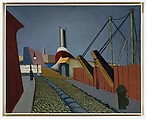Gansevoort, Number 1
Lee Krasner American
Not on view
Krasner studied at some of New York's best art schools (1926–32), including the Art Students League, Cooper Union, and the National Academy of Design, receiving a teaching degree from City College in 1933. The following year, while employed in the mural division of the government-sponsored Art Projects, she independently painted this small, somber canvas of the docks around Gansevoort Street, near the apartment she shared in West Greenwich Village. It is interesting to note that Krasner executed a large mural for the W.P.A. in a building on one of these Hudson River piers. She later recalled that during this period she "painted cityscapes, scenes out the window, or from a rooftop . . . [and] occasionally . . . would go down to the docks to paint."
In Gansevoort (and in a second 1935 version) the sharply defined lines and shapes of buildings, the streets and ship masts, as well as the dramatic recession into an eerily empty space, suggest the influence of the Italian metaphysical painter Giorgio de Chirico and the American Precisionists. Gansevoort, one of Krasner's few extant early paintings, gives little premonition of the radical departure her work would soon take toward Abstract Expressionism, under the influence of her teacher, Hans Hofmann, and husband, Jackson Pollock.
Due to rights restrictions, this image cannot be enlarged, viewed at full screen, or downloaded.

